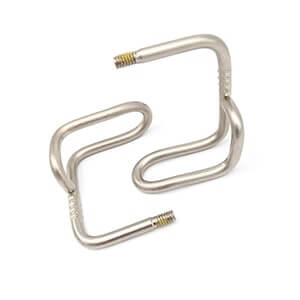Get unique, complex parts easily. No matter your requirements, Chaoyi Spring creates hard-to-produce coil springs and wire forms.
Let us help you create the custom wire form you need, from S-hooks and J-hooks to utility hooks and more.
We work closely with customers across a wide range of industries, helping them design and manufacture made-to-order parts.
Why choose Chaoyi Spring? We prioritize customer-focused collaboration, modern equipment and the latest technology to make your parts per print.
Find the information and guidance you need, from measuring a spring to learning about materials, placing an order and much more.
Springs, those ubiquitous coiled wonders, play a vital role in countless everyday objects, from simple door hinges to complex automotive suspensions. At the heart of their functionality lies a fundamental


Springs, those ubiquitous coiled wonders, play a vital role in countless everyday objects, from simple door hinges to complex automotive suspensions. At the heart of their functionality lies a fundamental equation that governs their behavior – the spring compression equation. This equation, a cornerstone of physics and engineering, unlocks the secrets of how springs store and release energy, providing insights into their crucial role in our world. Let's embark on a journey into the fascinating world of spring compression, exploring the equation that empowers these versatile devices.

Imagine a coil spring, patiently resting in its natural state. Now, apply a force that pushes the coils closer together – this is compression. As the spring compresses, it fights back, generating a force that resists further compression. This opposing force, known as the spring force, is directly proportional to the amount of compression, a principle embodied in Hooke's law.
Hooke's law, a foundational concept in physics, provides the mathematical framework for understanding spring compression. It states that the force (F) exerted by a spring is directly proportional to its displacement (x) from its equilibrium position. This relationship is elegantly expressed in the following equation:
F = -kx
Where:
The negative sign in the equation indicates that the spring force acts in the opposite direction to the compression force. This means that as you push on the spring (positive x), it pushes back (negative F), and vice versa.
The spring constant (k) is a crucial parameter that determines how stiff a spring is. A higher spring constant indicates a stiffer spring, meaning it requires a greater force to compress it by the same amount. This constant reflects the inherent properties of the spring material and its geometry.
A key takeaway is that the spring constant is a measure of the spring's resistance to compression. A higher spring constant means greater resistance to compression. This is a fundamental concept for understanding how springs behave under different loading conditions.
The spring compression equation finds widespread applications in various fields, from mechanical engineering to automotive design.
In automobiles, coil springs play a vital role in absorbing shocks and bumps on the road. The compression equation helps engineers design springs with appropriate stiffness to provide a smooth and comfortable ride while maintaining vehicle stability.
Springs are indispensable components in countless mechanical devices. In mechanisms like door hinges and spring-loaded locks, the compression equation ensures smooth and reliable operation. For example, in a spring-loaded lock, the compression equation determines how much force is needed to unlock the mechanism.
While Hooke's law provides a solid foundation for understanding spring compression, real-world scenarios often introduce complexities. Several factors can affect the compression behavior of a spring, including:
It's essential to acknowledge that Hooke's law is an approximation, and it holds true only within a specific range of compression. As the compression force increases, the spring may deviate from linear behavior, eventually reaching a point where it deforms permanently.
This nonlinear behavior is important to consider in applications involving high loads. For example, in heavy-duty machinery, engineers must account for the nonlinearity of springs to ensure their safe and reliable performance.
The spring compression equation provides a fundamental framework for understanding the behavior of springs. However, a deeper understanding requires delving into the intricacies of material science, spring geometry, and the complex interplay of forces.
For instance, the way a spring is coiled, the thickness of the wire, and the type of material used all influence its spring constant and overall compression behavior. Understanding these factors allows engineers to tailor springs for specific applications and optimize their performance.
The spring compression equation is more than just a mathematical formula; it embodies a fundamental principle of physics that governs the behavior of springs. Understanding this equation empowers us to design, analyze, and utilize these versatile devices in a wide range of applications.
From the simple act of opening a door to the complex mechanisms of modern technology, springs are everywhere, silently working to make our world function. By appreciating the science behind spring compression, we gain a deeper appreciation for the ingenuity and power of these seemingly ordinary but incredibly important devices.
The journey into the world of spring compression has revealed a fascinating interplay of forces, material properties, and mathematical principles. The equation, a testament to the elegance of physics, empowers us to understand and harness the power of these coiled wonders. As we continue to explore the intricacies of spring compression, we unlock even greater possibilities for innovation and advancement across diverse fields.
Browse some of the custom wire forms and springs that we manufacture. Don’t see what you need? We specialize in made-to-order products that meet your application requirements.
Visit Our GalleryNeed a custom wire form or coil spring? We make it work. Fill out the contact form and a representative will respond within 1 business day. If you have a PDF or CAD file, you can submit to request a quote.